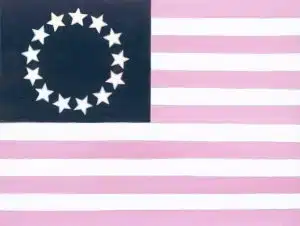In the work of American Impressionist Candace Whittemore Lovely, the layers of symbolism, intentionality, and pure poetic beauty unravel with an endless depth. So it is with this centerpiece of her trilogy of “Good and Lovely” flags, an interpretation of the early American Flag that lands chronologically between the other two Good and Lovely Flags (Confederate and Contemporary American), positioning it to pull together all sides in an all-inclusive embrace.
As history records, Philadelphia upholsterer Betsy Ross was commissioned by the state of Pennsylvania on May 29th, 1777 “for the making of flags,” a few months before Congress adopted the design as our nation’s first official national flag. The official version was a reconstruction of earlier flags including one in which the stars had 6 points and the famous semi-circle star iteration of 1976. Like Ross slightly reconstructing an existing design, so too, Lovely refashioned the standing elements within the bounds of her Good and Lovely collection to celebrate “great attractions.”
Poetry and Science
Lovely explains the original intent of the collection was to create “all the best attractions in black, white, and pink so my audience would understand what an attraction was, with the highest contrast (the biggest attraction, because opposites attract) being black and white, then adding the medium hue of pink.”
As in her similar piece, Good and Plenty America, here too Lovely says, “the outlines on the stars and stripes” (the literal shapes, not “the stars and stripes” nickname of the overall flag) “wobble against the hard line of the secondary color – their opposite – softening the edge, captured in the thin outline or rainbow hues bordering each pink stripe adding, a vibration of the primary color.” This is done (as are all her artistic decisions no matter how minute and ultra-fine) with pure intentionality as she seeks to directorially pull the viewer’s eye along in an ombre progression, “from the center where the red is, going out, that draws the eye to say, ‘look here first then look around. The warmest area is in the center, and the red goes out into the rainbow.”
Referring to this piece in context as a Revolutionary Flag, though it’s also known as America’s First Flag or the Betsy Ross Flag, Lovely touches on these descriptions as part of a larger whole of painting history and historical ideals.
Mentioning history as “the number one subject in the hierarchy of painting,” Lovely references the influence of “mid-century” American artist Jasper Johns whose 1955 painting of the contemporary American Flag was his first work to be acquired by the Metropolitan Museum of Art in 1998 for an undisclosed amount but which was estimated to be worth in excess of $20 Million.
An encaustic painting (involving hot wax) called White Flag, his approach to palette was the opposite of the Good and Lovely series as Johns sought to “drain the iconic subject of its characteristic red, white, and blue” as part of a series he described as “things the mind already knows.” But the approach to attraction and history were what reverberated with Lovely as she chose to create within this “most invaluable subject” for reasons of preservation, celebration, and attraction.
A trio, though not a tryptic (and part of her overarching “Good and Lovely” collection with a wide variety of subjects and works), here the artist honors the evolution of a nation, an ideal, and the inimitable Spirit of a people filled – then and now – with a hope for a brighter future. This hope – this attraction that draws to its shores “huddled masses yearning to breathe free” – encompasses the original, hard-won American Dream that believes “all men and women are created equal,” and “from that equal creation” have the right to “life, liberty, and the pursuit of happiness.”
With passion for what was originally woven into the nation’s first flag, Candace Lovely has expressed and seeks to sustain an eternally relevant truth within a Good and Lovely Hug.
About the Collection:
“Candace Lovely’s Good and Lovely collection was born of a 2001 gallery show featuring ‘the element of attraction, where each painting tells a story in black and white, with a medium hue of pink,’ according to Lovely. The idea and palette were inspired when she was painting one of her many ‘fair women on the shore’ paintings and noticed the combination of the model’s dark hair, black ribbons on a white dress, black dog, and the pink of the umbrella. ‘It reminded me of Good & Plenty™️ candies and how their bright colors made you feel’ (considering the candies themselves, the colors on the box, and the era that incorporated these colors into pop culture).”
